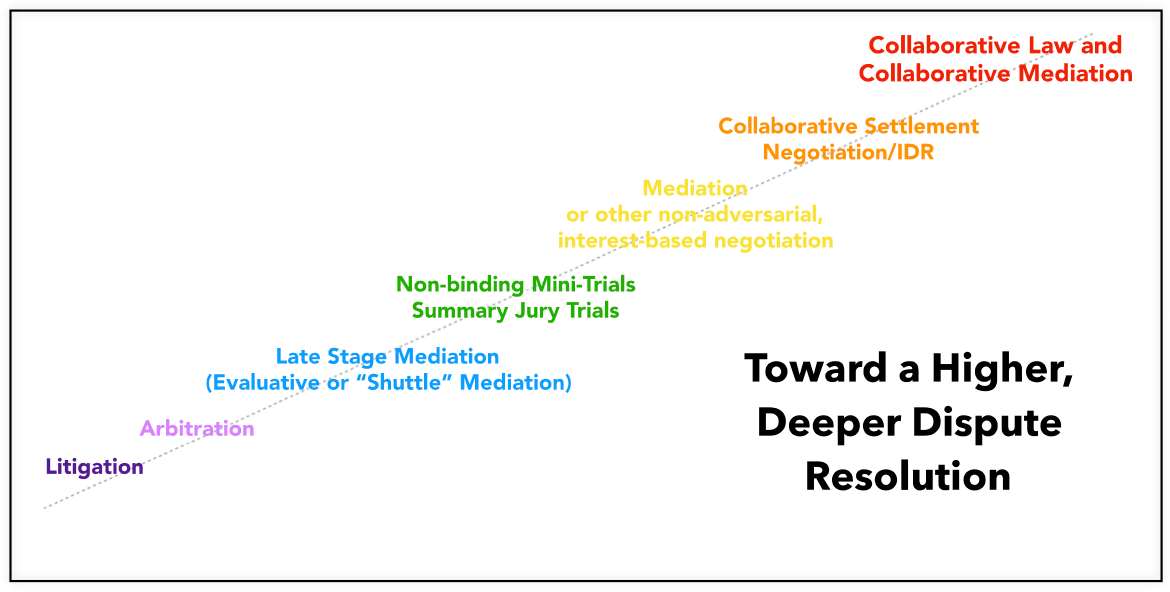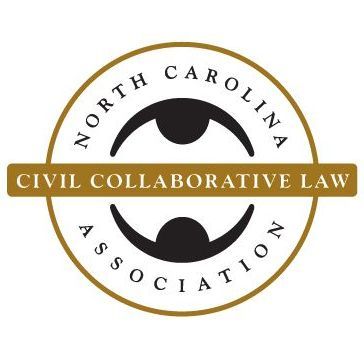The Alternative Dispute Resolution Spectrum
Many collaborative attorneys have extensive litigation experience and are well-equipped to deploy traditional litigation tools to achieve a desired result through the judicial process. As collaborative law attorneys, they have made a conscious choice to lean into advising clients in a more creative and non-adversarial problem-solving process, believing that in many cases getting to resolution without expensive, lengthy and adversarial litigation offers more options and better results to clients, allows win-win solutions, and avoids the substantial downside and risks of litigation.
So, do you represent a company or individual... and need to find an option... to resolve the matter in an expeditious, inexpensive, confidential and effective manner without litigation?
Does your client place greater value on retaining control over the outcome by taking a more active role in developing a creative resolution to a complex conflict?
If you answered yes to any of these questions, scroll down to read more about the Alternative Dispute Resolution Spectrum and learn about Identifying a Collaborative Law Case.
What is the Alternative Dispute Resolution Spectrum?
The Alternative Dispute Resolution (ADR)1 spectrum is a visual representation of dispute resolution processes from negotiation through litigation.

The ADR spectrum
"We Can Work it Out"
The parties do most of the communicating but may need assistance with final court orders. Best when issues can be resolved in an amicable manner. Learn more»
Pre-Litigation Mediation
Neutral third person assists the parties in negotiating. Best when issues are not too complex and parties are open to communication. Learn more»
Collaborative Law
Each party hires a lawyer trained to use negotiation tools to reach agreement. Best when parties are willing to work through difficult issues in a way aimed at preserving an amicable relationship. Learn more»
Negotiation/Mid-Litigation Mediation
Lawyers do most of the communicating. Mandatory for some issues. Best when there is significant mistrust and parties need advocates.
Binding Arbitration
Private lawyer acts as judge.
Litigation/Hearings/Trial
Traditional court-oriented process. Best when parties cannot communicate and there is little or no trust.
What is the difference between mediation and collaborative law?
Isn't collaborative law like mediation?
No. While both resolution options use negotiation tools and are valuable to resolving disputes, they are different. Collaborative Law is more interest-based and is not a positional form of negotiation. Additionally, Collaborative Law offers a more creative process regarding the types of remedies that can be fashioned in a dispute. Mediation is often included as a part of litigation, does not always encourage dialogue and open-exchange and often focuses more on settlement negotiations. The mediator works with the parties' positions, carrying information and numbers between the parties. This is often referred to as shuttle mediation. Because of this format, mediation can be viewed as a compromise rather than a common-interest based win/win solution. Generally, mediation occurs in between discovery or post-discovery and involves compromises and numbers as its focus.
Whereas, Collaborative Law has as its focus, problem-solving, preservation of relationships and/or a meeting of the minds through common-interests. Attorneys have become trained to continue litigation, get past summary judgment and focus on trial if the case does not settle in mediation. Collaborative law removes the focus from litigation and puts it exclusively on resolution. It empowers the parties in a different way as there are only the parties, their collaborative trained attorneys and any relevant neutrals involved in the resolution process. And while the parties do not forego their right to utilize litigation if the matter does not resolve, the biggest difference is the parties and all involved in the collaborative law process are required to enter into a written participation agreement not to litigate. This sets the tone and the trajectory for the resolution process. No other dispute resolution process does this.
Best use of collaborative law
The ABA states, "As mentioned, not all cases are suited for litigation and not all cases are suited for Collaborative Law. However, Collaborative Law will be tremendously advantageous to injured parties with legitimate claims who otherwise will likely go unrepresented. There are specific reasons for the failure of some would-be plaintiffs to secure legal representation. It is often not economically feasible for an attorney to take the case; the claim is too small; the injured party is too angry or just seeking revenge; or the claim is too difficult or too complicated to prove. It is particularly difficult for young or elderly plaintiffs to find attorneys because it is difficult, if not impossible, to prove economic damages [in certain types of cases, like personal injury or medical injury cases]; this difficulty is compounded in states that have caps on non-economic damages. In a situation in which an injured party sues and the process becomes too daunting, expensive or time- and emotion-consuming, the injured party (and her/his attorney) could move into a collaborative process, in the hope that an interest-based, face to-face process would bring a reasonably speedy resolution to the matter. These situations require a case-by-case analysis by the attorney and client to determine if the collaborative law process is useful and appropriate. This requirement, often referred to as the 'collaborative commitment,' is intended to ensure that the attorneys, as well as the parties, are fully committed to the collaborative process.2
- The use of the ADR spectrum is courtesy of Michael Zeytoonian and Chris Osborn.
- Clark, Kathleen, The Use of Collaborative Law in Medical Error Situations, https://apps.americanbar.org/dch/committee.cfm?com=DR035000.

